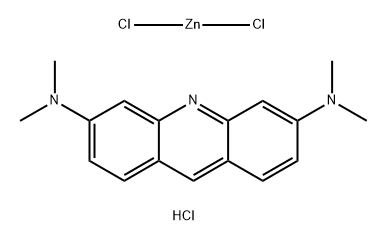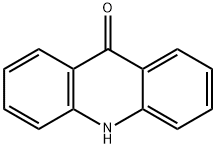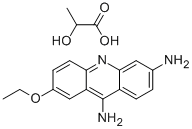9-Oxo-10(9H)-acridineacetic acid
Synonym(s):(9,10-Dihydro-9-oxo-10-acridinyl)acetic acid;10-(Carboxymethyl)-9(10H)acridone
- CAS NO.:38609-97-1
- Empirical Formula: C15H11NO3
- Molecular Weight: 253.25
- MDL number: MFCD00157050
- EINECS: 634-833-1
- SAFETY DATA SHEET (SDS)
- Update Date: 2025-01-27 09:38:02

What is 9-Oxo-10(9H)-acridineacetic acid?
Definition
Acriridone derivatives have become a research hotspot in the field of medicine in recent years due to their good antibacterial, anti-inflammatory, anti-malarial, and anti-cancer activities. This type of compound has a rigid planar structure of a macrocyclic conjugated system and can be embedded or Electrostatic attraction binds to DNA. Among them, 9-aminoacridine derivatives have good pharmacological and biological activities, and some of them have been used clinically as DNA embedding reagents. As an important pharmaceutical intermediate, 9-Oxo-10(9H)-acridineacetic acid has also received increasing attention. Cridanimod (9-Oxo-10(9H)-acridineacetic acid) is a potent progesterone receptor (PR) activator mediated through induction of IFNα and IFNβ expression. Cridanimod is a small-molecule immunomodulator and interferon inducer.
Description
9-Oxo-10(9H)-acridineacetic acid , also known as Cridanimod or XBIO-101, is a small molecule that can increase progesterone receptor (PR) expression, with potential antineoplastic adjuvant activity. Cridanimod is able to induce the expression of PR in endometrial cancer. This could increase the sensitivity of endometrial cancer cells to progestin monotherapy. In combination with a progestin, cancer cells could be eradicated through increased PR-mediated signaling, leading to an inhibition of luteinizing hormone (LH) release from the pituitary gland, via a negative feedback mechanism, and, eventually, an inhibition of estrogen release from the ovaries. This leads to an inhibition of cellular growth in estrogen-dependent tumor cells.
The Uses of 9-Oxo-10(9H)-acridineacetic acid
9-Oxo-10(9H)-acridineacetic acid is a reagent for pre-column derivatization of amino acids for fluorescent determination in HPLC and it is also a building block in pharmaceutics.
What are the applications of Application
9-Oxo-10(9H)-acridineacetic acid is a derivitization agent for amino acid purifications
Definition
ChEBI: Cridanimod is a member of acridines. It is functionally related to an acridone.
storage
Store at +4°C
Properties of 9-Oxo-10(9H)-acridineacetic acid
| Melting point: | ~289 °C (dec.) |
| Boiling point: | 486.6±34.0 °C(Predicted) |
| Density | 1.362 |
| storage temp. | Sealed in dry,Room Temperature |
| solubility | Aqueous Base (Slightly), DMSO (Slightly) |
| form | Solid |
| pka | 3.69±0.10(Predicted) |
| color | Pale Yellow to Light Yellow |
| λmax | 410nm(H2O)(lit.) |
| BRN | 227508 |
| InChI | InChI=1S/C15H11NO3/c17-14(18)9-16-12-7-3-1-5-10(12)15(19)11-6-2-4-8-13(11)16/h1-8H,9H2,(H,17,18) |
| CAS DataBase Reference | 38609-97-1(CAS DataBase Reference) |
Safety information for 9-Oxo-10(9H)-acridineacetic acid
| Signal word | Warning |
| Pictogram(s) |
 Exclamation Mark Irritant GHS07 |
| GHS Hazard Statements |
H315:Skin corrosion/irritation H319:Serious eye damage/eye irritation H335:Specific target organ toxicity, single exposure;Respiratory tract irritation |
| Precautionary Statement Codes |
P261:Avoid breathing dust/fume/gas/mist/vapours/spray. P305+P351+P338:IF IN EYES: Rinse cautiously with water for several minutes. Remove contact lenses, if present and easy to do. Continuerinsing. |
Computed Descriptors for 9-Oxo-10(9H)-acridineacetic acid
| InChIKey | UOMKBIIXHQIERR-UHFFFAOYSA-N |
| SMILES | C1=C2C(N(CC(O)=O)C3=C(C2=O)C=CC=C3)=CC=C1 |
New Products
1-Boc-4-cyanopiperidine tert-Butyl carbazate 1-(TERT-BUTOXYCARBONYL)-2-PYRROLIDINONE TETRABUTYLAMMONIUM CYANIDE TETRAHYDRO-2H-PYRAN-3-OL 3-Pyridineacrylic acid Nickel(II) perchlorate hexahydrate, 98% 4-Bromophenylacetonitrile, 95% 3-Bromo-4-fluoroaniline, 97% Sodium tetraborate decahydrate, 98% Palladium(II) acetate, trimer, Pd 99% 4-Bromo-2-chlorotoluene, 97% Tadalafil Clopidogrel bisulfate Sitagliptin Phosphate Monohydrate Cabergoline Fexofinadine HCl Etoricoxib 4-Amino Acetophenone 2-Chloro Acetophenone Amlodipine Base 2,3,5-Triiodobenzoic Acid Pyrrolidine Diiodo PentoxideRelated products of tetrahydrofuran








You may like
-
 9-Oxoacridine-10-acetic Acid CAS 38609-97-1View Details
9-Oxoacridine-10-acetic Acid CAS 38609-97-1View Details
38609-97-1 -
 9-Oxo-10(9H)-acridineacetic acid CAS 38609-97-1View Details
9-Oxo-10(9H)-acridineacetic acid CAS 38609-97-1View Details
38609-97-1 -
 366789-02-8 Riveroxaban 98%View Details
366789-02-8 Riveroxaban 98%View Details
366789-02-8 -
 Carvedilol 98%View Details
Carvedilol 98%View Details
72956-09-3 -
 Abiretorone 154229-18-2 98%View Details
Abiretorone 154229-18-2 98%View Details
154229-18-2 -
 73590-58-6 Omeprazole 98%View Details
73590-58-6 Omeprazole 98%View Details
73590-58-6 -
 201530-41-8 Deferasirox 98%View Details
201530-41-8 Deferasirox 98%View Details
201530-41-8 -
 Sertraline HCl 98%View Details
Sertraline HCl 98%View Details
79559-97-0
